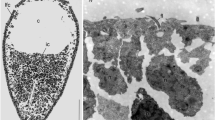Summary
The fine structure of Heterophrys marina (Centrohelidia, Heliozoa) is described with special reference to centroplast structure, morphogenesis and “behaviour” of kinetocysts (= axopodial granules which perform saltatory movement), and formation of organic spicules in a new type of organelle located in the plasma membrane. A low calcium pretreatment and fixation was used to improve preservation of highly labile axopodia which near their distal end contain a single microtubule (MT) only. Two varieties of H. marina with a respective maximum of 6 and 12 MTs per axopodium, and 2 hitherto undescribed species, H. elati and H. multipoda, were found among 9 stocks collected in Europe and North America. In all species only the central 6 MTs of each axoneme originate from a scaffolding layer of electron dense material which surrounds the central granule. Evidence is presented which indicates that in Heterophrys self-linkage is not the only principle of MT pattern generation but that instead precisely localized MT nucleation and specific linkage of MTs within the cortex of the centroplast lead to the MT patterns observed. Prekinetocysts originate from vesicles found in the neighborhood of the dictyosomes. After maturation the kinetocysts become attached to the plasma membrane which seems to play an important role both in selection of particles transported in the axopodia and particle movement as well.
Similar content being viewed by others
References
Bardele, C. F.: Ultrastruktur der “Körnchen” auf den Axopodien von Raphidiophrys (Centrohelida, Heliozoa). Z. Naturforsch. 24b, 362–363 (1969)
Bardele, C. F.: Comparative ultrastructural studies on Centrohelida. J. Protozool. 17 (Suppl.), 10–11 (1970)
Bardele, C. P.: Microtubule model systems: Cytoplasmic transport in the suctorian tentacle and the centrohelidian axopod. In: 29th Annual EMSA Meeting (ed. C. J. Arceneaux), p. 334–335. Baton Rouge: Claitor's Publishing Division 1971
Bardele, C. F.: Cell cycle, morphogenesis, and ultrastructure in the pseudoheliozoan Clathrulina elegans. Z. Zellforsch. 130, 219–242 (1972)
Bardele, C. F.: The dynamics of the heliozoan axopod. Progress in Protozoology, 4th Intern. Congress on Protozoology, Clermont-Ferrand (1973a)
Bardele, C. F.: Struktur, Biochemie und Funktion der Mikrotubuli. Cytobiologie 7, 442–488 (1973b)
Borisy, G. G., Olmsted, J. B.: Nucleated assembly of microtubules in porcine brain extracts. Science 177, 1196–1197 (1972)
Davidson, L. A.: Ultrastructure of the heliozoan Heterophrys marina and the helioflagellate Ciliophrys marina. J. Ultrastruct. Res. 38, 219 (1972)
Davidson, L.: Contractile axopodia of the centrohelidian heliozoan Heterophrys marina. J. Cell Biol. 59, 71a (1973)
Davidson, L.: Ph. D. Thesis. University of California at Berkeley, 1974
Dobell, C.: On Oxnerella maritima, nov. gen., nov. spec., a new Heliozoan, and its method of division; with some remarks on the centroplast of the heliozoa. Quart. J. micr. Sci. 62, 515–538 (1917)
Edds, K.: Particle movements in artificial axopodia of Eehinosphaerium nucleofilum. J. Cell Biol. 59, 88a (1973)
Fitzharris, T. P., Bloodgood, R. A., McIntosh, J. R.: Particle movement in the axopodia of Echinosphaerium: Evidence concerning the role of the axoneme. J. Mechanochem. Cell Motility 1, 117–124 (1972)
Föyn, B.: Lebenszyklus, Cytologie und Sexualität der Chlorophycee Gladophora Suhriana Kützing. Arch. Protistenk. 83, 1–56 (1934)
Harris, P.: Some structural and functional aspects of the mitotic apparatus in sea urchin embryos. J. Cell Biol. 14, 475–487 (1962)
Hayat, M. A.: Principles and techniques of electron microscopy. Biological applications, vol. 1. New York: Van Nostrand Reinhold Company 1970
Hepler, P. K., Palevitz, B. A.: Microtubules and microfilaments. Ann. Rev. Plant Physiol. 25, 309–362 (1974)
Hertwig, R., Lesser, E.: Über Rhizopoden und denselben nahestehende Organismen, III. Teil Heliozoa. Arch. mikr. Anat. 10 (Suppl.), 147–236 (1874)
Kormos, J.: On the structure of the centroplast. Acta biol. Acad. Sci. hung. 22, 81–83 (1971)
Manton, I.: Further observations on scale formation in Chrysochromulina chiton. J. Cell Sci. 2, 411–418 (1967)
McGee-Russell, S. M., Allen, R. D.: Reversible stabilization of labile microtubules in the reticulopodial network of Allogromia. In: Advances in cell and molecular biology (ed. E. J. DuPraw), vol. 1, p. 153–184. New York: Academic Press 1971
Ockleford, C. D., Tucker, J. B.: Growth, breakdown, repair and rapid contraction of microtubular axopodia in the heliozoan Actinophrys sol. J. Ultrastruct. Res. 44, 369–387 (1973)
Penard, E.: Les Héliozoaires d'eau douce. Genève: Kündig 1904
Pickett-Heaps, J. D.: The evolution of the mitotic apparatus: An attempt at comparative ultrastructrual cytology in dividing plant cells. Cytobios 1, 257–280 (1969)
Rebhun, L. I.: Polarized intracellular particle transport: Saltatory movements and cytoplasmic streaming. Int. Rev. Cytol. 32, 93–137 (1972)
Roberts, K.: Cytoplasmic microtubules and their functions. In: Progress in biophysics and molecular biology, vol. 28, p. 371–420. Oxford and New York: Pergamon Press 1974
Satir, B.: Membrane events during the secretory process. In: Transport at the cellular level. Symp. Soc. Exp. Biol., vol. 28, p. 399–418. Cambridge: University Press 1974
Singer, S. J., Nicolson, G. L.: The fluid mosaic model of the structures of cell membranes. Science 175, 720–731 (1972)
Schnepf, E., Deichgräber, G.: Über die Feinstruktur von Synura petersenii unter besonderer Berücksichtigung der Morphogenese ihrer Kieselschuppen. Protoplasma 68, 85–106 (1969)
Tilney, L. G.: How microtubule patterns are generated. The relative importance of nucleation and bridging of microtubules in the formation of the axoneme of Raphidiophrys. J. Cell Biol. 51, 837–854 (1971)
Tilney, L. G., Bryan, J., Bush, D. J., Fujiwara, K., Mooseker, M. S., Murphy, D. B., Snyder, D. H.: Microtubules: evidence for 13 protofilaments. J. Cell Biol. 59, 267–275 (1973)
Weisenberg, R. C.: Microtubule formation in vitro in solutions containing low calcium concentration. Science 177, 1104–1105 (1972)
Wohlfarth-Bottermann, K. E., Krüger, F.: Protistenstudien VI. Die Feinstruktur der Axopodien und der Skelettn adeln von Heliozoen. Protoplasma 43, 177–191 (1954)
Author information
Authors and Affiliations
Additional information
The author thanks Anne Vees for excellent technical assistance. This study was sponsored by the Deutsche Forschungsgemeinschaft. Field trips to Naples and Woods Hole were supported by NATO Research Grant No. 657 to Dr. L. E. Roth, Kansas State University, Manhattan, Kansas, and the author.
Rights and permissions
About this article
Cite this article
Bardele, C.F. The fine structure of the centrohelidian Heliozoan Heterophrys marina . Cell Tissue Res. 161, 85–102 (1975). https://doi.org/10.1007/BF00222116
Received:
Issue Date:
DOI: https://doi.org/10.1007/BF00222116




